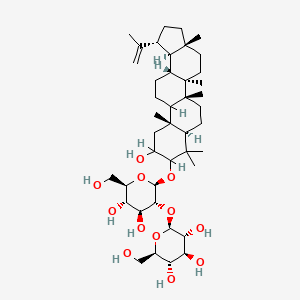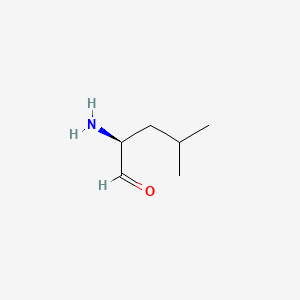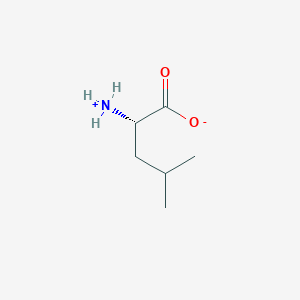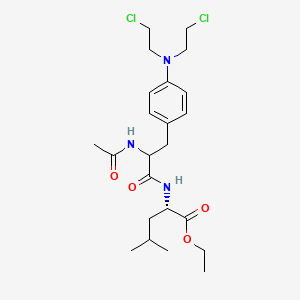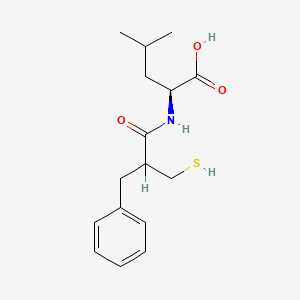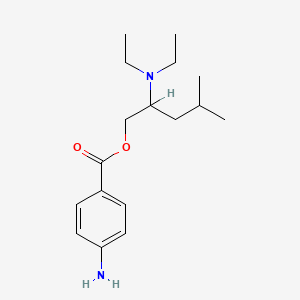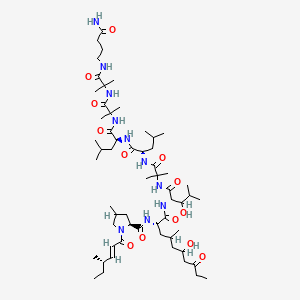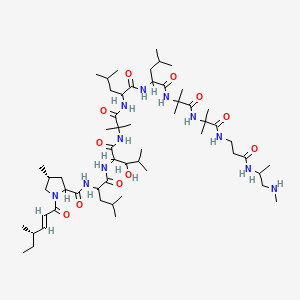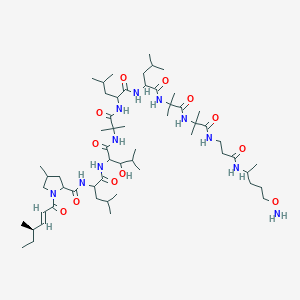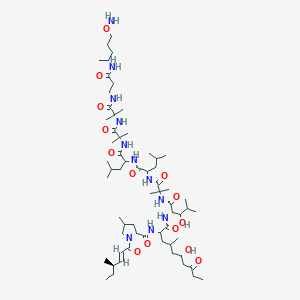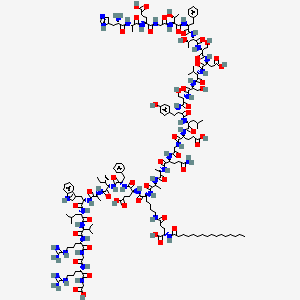
Liraglutide
Overview
Description
Liraglutide is a synthetic analog of human glucagon-like peptide-1, which is used primarily in the treatment of type 2 diabetes mellitus and obesity . It is marketed under the brand names Victoza and Saxenda . This compound mimics the action of the natural hormone glucagon-like peptide-1, which helps regulate blood sugar levels and appetite .
Mechanism of Action
Target of Action
Liraglutide is a synthetic analog of human glucagon-like peptide-1 (GLP-1) and acts as a GLP-1 receptor agonist . It is 97% similar to native human GLP-1, differing primarily by substituting arginine for lysine at position 34 .
Mode of Action
This compound interacts with its target, the GLP-1 receptor, leading to increased intracellular cyclic AMP (cAMP). This results in insulin release in the presence of elevated glucose concentrations . The insulin secretion subsides as blood glucose concentrations decrease and approach euglycemia .
Biochemical Pathways
This compound affects multiple biochemical pathways. It activates the AMPK/ACC signaling pathway, which plays a crucial role in cellular energy homeostasis . It also interacts with specific neurons in the hypothalamus, involved in the regulation of appetite and food intake . Furthermore, it has been reported to increase the expression of the mammalian target of rapamycin (mTOR) in hippocampus tissue in diabetic rats via the AMP-activated protein kinase (AMPK) and PI3K/AKT pathways .
Pharmacokinetics
This compound is slowly absorbed following subcutaneous injection, with a maximum concentration time (tmax) of approximately 12 hours . Its absolute bioavailability is around 55% . The mechanism of protraction relates to slowed release from the injection site, and a reduced elimination rate owing to metabolic stabilization and reduced renal filtration .
Result of Action
This compound can alleviate the decrease of cell viability and degradation of muscle protein caused by high glucose, and improves cell metabolism and mitochondrial activity . It also inhibits lung cancer cell proliferation in vitro and in vivo . In addition, this compound exhibited anti-aging effects in vivo and in vitro .
Biochemical Analysis
Biochemical Properties
Liraglutide plays a significant role in biochemical reactions. It interacts with various enzymes, proteins, and other biomolecules. For instance, it has been found to interact with glucagon-like peptide 1 receptor (GLP-1R), which is a G protein-coupled receptor . The nature of these interactions involves binding to the receptor, which triggers a series of biochemical reactions leading to the secretion of insulin .
Cellular Effects
This compound has profound effects on various types of cells and cellular processes. It influences cell function by impacting cell signaling pathways, gene expression, and cellular metabolism. For instance, it has been found to preserve pancreatic beta cells via regulation of cell kinetics and suppression of oxidative and endoplasmic reticulum stress in a mouse model of diabetes .
Molecular Mechanism
The mechanism of action of this compound is quite complex. It exerts its effects at the molecular level through binding interactions with biomolecules, enzyme inhibition or activation, and changes in gene expression. For instance, it binds to the GLP-1R, which leads to the activation of adenylyl cyclase and an increase in cyclic AMP levels .
Temporal Effects in Laboratory Settings
In laboratory settings, the effects of this compound change over time. It has been found to have a half-life of more than 13 hours, indicating its stability . Long-term effects on cellular function observed in in vitro or in vivo studies include improved insulin sensitivity and glucose homeostasis .
Dosage Effects in Animal Models
The effects of this compound vary with different dosages in animal models. For instance, in db/db mice, this compound treatment improved metabolic variables and insulin sensitivity .
Metabolic Pathways
This compound is involved in several metabolic pathways. It interacts with enzymes such as adenylyl cyclase and influences metabolic flux and metabolite levels .
Transport and Distribution
This compound is transported and distributed within cells and tissues. It is administered as an isotonic solution by subcutaneous injection .
Subcellular Localization
Given its role in activating the GLP-1R, it is likely that it is localized to the cell membrane where this receptor is found .
Preparation Methods
Synthetic Routes and Reaction Conditions
Liraglutide is synthesized by attaching a C-16 fatty acid (palmitic acid) with a glutamic acid spacer to the lysine residue at position 26 of the peptide precursor . The synthesis involves solid-phase peptide synthesis techniques, where amino acids are sequentially added to a growing peptide chain anchored to a solid resin . The final product is then cleaved from the resin and purified using high-performance liquid chromatography .
Industrial Production Methods
Industrial production of this compound involves large-scale solid-phase peptide synthesis followed by purification using chromatography techniques . The process is optimized to ensure high yield and purity of the final product, which is essential for its therapeutic efficacy .
Chemical Reactions Analysis
Types of Reactions
Liraglutide undergoes various chemical reactions, including:
Oxidation: This compound can be oxidized at the methionine residues, which may affect its stability and activity.
Reduction: Reduction reactions are less common but can occur under specific conditions.
Substitution: Substitution reactions can occur at the amino acid residues, potentially altering the peptide’s structure and function.
Common Reagents and Conditions
Oxidation: Hydrogen peroxide or other oxidizing agents can be used under controlled conditions.
Reduction: Reducing agents like dithiothreitol can be used.
Substitution: Various chemical reagents can be used to introduce substitutions at specific residues.
Major Products Formed
The major products formed from these reactions include oxidized or reduced forms of this compound, which may have different pharmacological properties .
Scientific Research Applications
Liraglutide has a wide range of scientific research applications:
Chemistry: Used as a model peptide for studying peptide synthesis and modification techniques.
Biology: Investigated for its role in regulating glucose metabolism and appetite.
Medicine: Extensively studied for its therapeutic effects in type 2 diabetes and obesity.
Industry: Used in the development of new peptide-based therapeutics.
Comparison with Similar Compounds
Similar Compounds
Semaglutide: Another glucagon-like peptide-1 receptor agonist used for similar indications.
Exenatide: A shorter-acting glucagon-like peptide-1 receptor agonist.
Dulaglutide: A long-acting glucagon-like peptide-1 receptor agonist.
Uniqueness
Liraglutide is unique due to its once-daily dosing regimen and its ability to significantly reduce body weight in addition to improving glycemic control . Unlike some other glucagon-like peptide-1 receptor agonists, this compound has been shown to have beneficial effects on cardiovascular outcomes .
Properties
IUPAC Name |
(2S)-5-[[(5S)-5-[[(2S)-2-[[(2S)-2-[[(2S)-5-amino-2-[[2-[[(2S)-2-[[(2S)-2-[[(2S)-2-[[(2S)-2-[[(2S)-2-[[(2S)-2-[[(2S)-2-[[(2S)-2-[[(2S,3R)-2-[[(2S)-2-[[(2S,3R)-2-[[2-[[(2S)-2-[[(2S)-2-[[(2S)-2-amino-3-(1H-imidazol-5-yl)propanoyl]amino]propanoyl]amino]-4-carboxybutanoyl]amino]acetyl]amino]-3-hydroxybutanoyl]amino]-3-phenylpropanoyl]amino]-3-hydroxybutanoyl]amino]-3-hydroxypropanoyl]amino]-3-carboxypropanoyl]amino]-3-methylbutanoyl]amino]-3-hydroxypropanoyl]amino]-3-hydroxypropanoyl]amino]-3-(4-hydroxyphenyl)propanoyl]amino]-4-methylpentanoyl]amino]-4-carboxybutanoyl]amino]acetyl]amino]-5-oxopentanoyl]amino]propanoyl]amino]propanoyl]amino]-6-[[(2S)-1-[[(2S)-1-[[(2S,3S)-1-[[(2S)-1-[[(2S)-1-[[(2S)-1-[[(2S)-1-[[(2S)-5-carbamimidamido-1-[[2-[[(2S)-5-carbamimidamido-1-(carboxymethylamino)-1-oxopentan-2-yl]amino]-2-oxoethyl]amino]-1-oxopentan-2-yl]amino]-3-methyl-1-oxobutan-2-yl]amino]-4-methyl-1-oxopentan-2-yl]amino]-3-(1H-indol-3-yl)-1-oxopropan-2-yl]amino]-1-oxopropan-2-yl]amino]-3-methyl-1-oxopentan-2-yl]amino]-1-oxo-3-phenylpropan-2-yl]amino]-4-carboxy-1-oxobutan-2-yl]amino]-6-oxohexyl]amino]-2-(hexadecanoylamino)-5-oxopentanoic acid | |
|---|---|---|
| Source | PubChem | |
| URL | https://pubchem.ncbi.nlm.nih.gov | |
| Description | Data deposited in or computed by PubChem | |
InChI |
InChI=1S/C172H265N43O51/c1-18-20-21-22-23-24-25-26-27-28-29-30-37-53-129(224)195-116(170(265)266)59-64-128(223)180-68-41-40-50-111(153(248)199-115(62-67-135(232)233)154(249)204-120(73-100-44-33-31-34-45-100)159(254)214-140(93(11)19-2)167(262)192-97(15)146(241)201-122(76-103-79-183-108-49-39-38-48-106(103)108)157(252)203-118(72-90(5)6)158(253)212-138(91(7)8)165(260)200-110(52-43-70-182-172(177)178)149(244)184-81-130(225)193-109(51-42-69-181-171(175)176)148(243)187-84-137(236)237)196-144(239)95(13)189-143(238)94(12)191-152(247)114(58-63-127(174)222)194-131(226)82-185-151(246)113(61-66-134(230)231)198-155(250)117(71-89(3)4)202-156(251)119(75-102-54-56-105(221)57-55-102)205-162(257)124(85-216)208-164(259)126(87-218)209-166(261)139(92(9)10)213-161(256)123(78-136(234)235)206-163(258)125(86-217)210-169(264)142(99(17)220)215-160(255)121(74-101-46-35-32-36-47-101)207-168(263)141(98(16)219)211-132(227)83-186-150(245)112(60-65-133(228)229)197-145(240)96(14)190-147(242)107(173)77-104-80-179-88-188-104/h31-36,38-39,44-49,54-57,79-80,88-99,107,109-126,138-142,183,216-221H,18-30,37,40-43,50-53,58-78,81-87,173H2,1-17H3,(H2,174,222)(H,179,188)(H,180,223)(H,184,244)(H,185,246)(H,186,245)(H,187,243)(H,189,238)(H,190,242)(H,191,247)(H,192,262)(H,193,225)(H,194,226)(H,195,224)(H,196,239)(H,197,240)(H,198,250)(H,199,248)(H,200,260)(H,201,241)(H,202,251)(H,203,252)(H,204,249)(H,205,257)(H,206,258)(H,207,263)(H,208,259)(H,209,261)(H,210,264)(H,211,227)(H,212,253)(H,213,256)(H,214,254)(H,215,255)(H,228,229)(H,230,231)(H,232,233)(H,234,235)(H,236,237)(H,265,266)(H4,175,176,181)(H4,177,178,182)/t93-,94-,95-,96-,97-,98+,99+,107-,109-,110-,111-,112-,113-,114-,115-,116-,117-,118-,119-,120-,121-,122-,123-,124-,125-,126-,138-,139-,140-,141-,142-/m0/s1 | |
| Source | PubChem | |
| URL | https://pubchem.ncbi.nlm.nih.gov | |
| Description | Data deposited in or computed by PubChem | |
InChI Key |
YSDQQAXHVYUZIW-QCIJIYAXSA-N | |
| Source | PubChem | |
| URL | https://pubchem.ncbi.nlm.nih.gov | |
| Description | Data deposited in or computed by PubChem | |
Canonical SMILES |
CCCCCCCCCCCCCCCC(=O)NC(CCC(=O)NCCCCC(C(=O)NC(CCC(=O)O)C(=O)NC(CC1=CC=CC=C1)C(=O)NC(C(C)CC)C(=O)NC(C)C(=O)NC(CC2=CNC3=CC=CC=C32)C(=O)NC(CC(C)C)C(=O)NC(C(C)C)C(=O)NC(CCCNC(=N)N)C(=O)NCC(=O)NC(CCCNC(=N)N)C(=O)NCC(=O)O)NC(=O)C(C)NC(=O)C(C)NC(=O)C(CCC(=O)N)NC(=O)CNC(=O)C(CCC(=O)O)NC(=O)C(CC(C)C)NC(=O)C(CC4=CC=C(C=C4)O)NC(=O)C(CO)NC(=O)C(CO)NC(=O)C(C(C)C)NC(=O)C(CC(=O)O)NC(=O)C(CO)NC(=O)C(C(C)O)NC(=O)C(CC5=CC=CC=C5)NC(=O)C(C(C)O)NC(=O)CNC(=O)C(CCC(=O)O)NC(=O)C(C)NC(=O)C(CC6=CN=CN6)N)C(=O)O | |
| Source | PubChem | |
| URL | https://pubchem.ncbi.nlm.nih.gov | |
| Description | Data deposited in or computed by PubChem | |
Isomeric SMILES |
CCCCCCCCCCCCCCCC(=O)N[C@@H](CCC(=O)NCCCC[C@@H](C(=O)N[C@@H](CCC(=O)O)C(=O)N[C@@H](CC1=CC=CC=C1)C(=O)N[C@@H]([C@@H](C)CC)C(=O)N[C@@H](C)C(=O)N[C@@H](CC2=CNC3=CC=CC=C32)C(=O)N[C@@H](CC(C)C)C(=O)N[C@@H](C(C)C)C(=O)N[C@@H](CCCNC(=N)N)C(=O)NCC(=O)N[C@@H](CCCNC(=N)N)C(=O)NCC(=O)O)NC(=O)[C@H](C)NC(=O)[C@H](C)NC(=O)[C@H](CCC(=O)N)NC(=O)CNC(=O)[C@H](CCC(=O)O)NC(=O)[C@H](CC(C)C)NC(=O)[C@H](CC4=CC=C(C=C4)O)NC(=O)[C@H](CO)NC(=O)[C@H](CO)NC(=O)[C@H](C(C)C)NC(=O)[C@H](CC(=O)O)NC(=O)[C@H](CO)NC(=O)[C@H]([C@@H](C)O)NC(=O)[C@H](CC5=CC=CC=C5)NC(=O)[C@H]([C@@H](C)O)NC(=O)CNC(=O)[C@H](CCC(=O)O)NC(=O)[C@H](C)NC(=O)[C@H](CC6=CN=CN6)N)C(=O)O | |
| Source | PubChem | |
| URL | https://pubchem.ncbi.nlm.nih.gov | |
| Description | Data deposited in or computed by PubChem | |
Molecular Formula |
C172H265N43O51 | |
| Source | PubChem | |
| URL | https://pubchem.ncbi.nlm.nih.gov | |
| Description | Data deposited in or computed by PubChem | |
DSSTOX Substance ID |
DTXSID60174433 | |
| Record name | Liraglutide | |
| Source | EPA DSSTox | |
| URL | https://comptox.epa.gov/dashboard/DTXSID60174433 | |
| Description | DSSTox provides a high quality public chemistry resource for supporting improved predictive toxicology. | |
Molecular Weight |
3751 g/mol | |
| Source | PubChem | |
| URL | https://pubchem.ncbi.nlm.nih.gov | |
| Description | Data deposited in or computed by PubChem | |
Mechanism of Action |
Liraglutide is an acylated synthetic glucagon-like peptide-1 analog. Liraglutide is an agonist of the glucagon-like peptide-1 receptor which is coupled to adenylate cyclase. The increase in cyclic AMP stimulates the glucose dependant release of insulin, inhibits the glucose dependant release of glucagon, and slows gastric emptying to increase control of blood sugar., Liraglutide is an acylated, long-acting, human glucagon-like peptide-1 (GLP-1) receptor agonist; the synthetic (recombinant DNA origin) peptide precursor of liraglutide has 97% amino acid sequence homology to endogenous human GLP-1-(7-37). Liraglutide is prepared by attaching palmitic acid with a glutamic acid spacer on the lysine residue at position 26 of the peptide precursor. GLP-1-(7-37) represents less than 20% of total circulating endogenous GLP-1. Like GLP-1-(7-37), liraglutide activates the GLP-1 receptor in pancreatic beta cells. Liraglutide also increases intracellular cyclic 3',5'-adenosine monophosphate (cAMP) leading to insulin release in the presence of elevated glucose concentrations. This insulin secretion subsides as blood glucose concentrations decrease and approach euglycemia. In addition, liraglutide suppresses glucagon secretion in a glucose-dependent manner but does not impair normal glucagon response to hypoglycemia. Liraglutide delays gastric emptying, reducing the rate at which postprandial glucose appears in the circulation. As a result of these actions resulting in increased insulin secretion, suppression of glucagon secretion, and delays in gastric emptying, liraglutide effectively reduces fasting and postprandial plasma glucose concentrations in patients with type 2 diabetes mellitus., Liraglutide is a glucagon-like peptide-1 (GLP-1) mimetic used for the treatment of Type 2 diabetes. Similar to the actions of endogenous GLP-1, liraglutide potentiates the post-prandial release of insulin, inhibits glucagon release and increases satiety. Recent epidemiological studies and clinical trials have suggested that treatment with GLP-1 mimetics may also diminish the risk of cardiovascular disease in diabetic patients. The mechanism responsible for this effect has yet to be determined; however, one possibility is that they might do so by a direct effect on vascular endothelium. Since low grade inflammation of the endothelium is an early event in the pathogenesis of atherosclerotic cardiovascular disease (ASCVD), we determined the effects of liraglutide on inflammation in cultured human aortic endothelial cells (HAECs). Liraglutide reduced the inflammatory responses to TNFalpha and LPS stimulation, as evidenced by both reduced protein expression of the adhesion molecules VCAM-1 and E-Selectin, and THP-1 monocyte adhesion. This was found to result from increased cell Ca2+ and several molecules sensitive to Ca2+ with known anti inflammatory actions in endothelial cells, including CaMKKbeta, CaMKI, AMPK, eNOS and CREB. Treatment of the cells with STO-609, a CaMKK inhibitor, diminished both the activation of AMPK, CaMKI and the inhibition of TNFa and LPS-induced monocyte adhesion by liraglutide. Likewise, expression of an shRNA against AMPK nullified the anti-inflammatory effects of liraglutide. The results indicate that liraglutide exerts a strong anti-inflammatory effect on HAECs. They also demonstrate that this is due to its ability to increase intracellular Ca2+ and activate CAMKKbeta, which in turn activates AMPK., In vivo, liraglutide lowers blood glucose and body weight in a number of diabetic and obese models using rodents, pigs and monkeys. The mechanism of action in vivo involved glucose-dependent increase in insulin secretion, lowered glucagon secretion, decreased gastric emptying, loss of body fat, lowered food intake, altered food preference, and maintained energy expenditure. The mechanism of action is consistent with a specific GLP-1 effect., Liraglutide is a long-acting GLP-1 analogue, designed to bind to albumin as the main molecular mechanism of protraction. In vitro, this was shown in the receptor cAMP as well as binding assay where addition of albumin right-shifted the dose-response and/or binding curve. The apparent reduced potency of liraglutide underlines that only the free fraction of liraglutide is responsible for its pharmacological effect in vitro as well as in vivo. Furthermore, liraglutide in a pharmaceutical solution forms a micell-like heptamer which may contribute to the slow absorption from the subcutis. | |
| Record name | Liraglutide | |
| Source | DrugBank | |
| URL | https://www.drugbank.ca/drugs/DB06655 | |
| Description | The DrugBank database is a unique bioinformatics and cheminformatics resource that combines detailed drug (i.e. chemical, pharmacological and pharmaceutical) data with comprehensive drug target (i.e. sequence, structure, and pathway) information. | |
| Explanation | Creative Common's Attribution-NonCommercial 4.0 International License (http://creativecommons.org/licenses/by-nc/4.0/legalcode) | |
| Record name | Liraglutide | |
| Source | Hazardous Substances Data Bank (HSDB) | |
| URL | https://pubchem.ncbi.nlm.nih.gov/source/hsdb/8205 | |
| Description | The Hazardous Substances Data Bank (HSDB) is a toxicology database that focuses on the toxicology of potentially hazardous chemicals. It provides information on human exposure, industrial hygiene, emergency handling procedures, environmental fate, regulatory requirements, nanomaterials, and related areas. The information in HSDB has been assessed by a Scientific Review Panel. | |
CAS No. |
204656-20-2 | |
| Record name | Liraglutide [USAN:INN:BAN:JAN] | |
| Source | ChemIDplus | |
| URL | https://pubchem.ncbi.nlm.nih.gov/substance/?source=chemidplus&sourceid=0204656202 | |
| Description | ChemIDplus is a free, web search system that provides access to the structure and nomenclature authority files used for the identification of chemical substances cited in National Library of Medicine (NLM) databases, including the TOXNET system. | |
| Record name | Liraglutide | |
| Source | DrugBank | |
| URL | https://www.drugbank.ca/drugs/DB06655 | |
| Description | The DrugBank database is a unique bioinformatics and cheminformatics resource that combines detailed drug (i.e. chemical, pharmacological and pharmaceutical) data with comprehensive drug target (i.e. sequence, structure, and pathway) information. | |
| Explanation | Creative Common's Attribution-NonCommercial 4.0 International License (http://creativecommons.org/licenses/by-nc/4.0/legalcode) | |
| Record name | Liraglutide | |
| Source | EPA DSSTox | |
| URL | https://comptox.epa.gov/dashboard/DTXSID60174433 | |
| Description | DSSTox provides a high quality public chemistry resource for supporting improved predictive toxicology. | |
| Record name | Liraglutide (2S)-5-[[(5S)-5-[[(2S)-2-[[(2S)-2-[[(2S)-5-amino-2-[[2-[[(2S)-2-[[(2S)-2-[[(2S)-2-[[(2S)-2-[[(2S)-2-[[(2S)-2- [[(2S)-2-[[(2S)-2-[[(2S,3R)-2-[[(2S)-2-[[(2S,3R)-2-[[2-[[(2S)-2-[[(2S)-2-[[(2S)-2-amino-3-(1H-imidazol-5-yl) propanoyl]amino]propanoyl]amino]-4-carboxybutanoyl]amino]acetyl]amino]-3-hydroxybutanoyl]amino]-3- phenylpropanoyl]amino]-3-hydroxybutanoyl]amino]-3-hydroxypropanoyl]amino]-3-carboxypropanoyl]amino]- 3-methylbutanoyl]amino]-3-hydroxypropanoyl]amino]-3-hydroxypropanoyl]amino]-3-(4-hydroxyphenyl) propanoyl]amino]-4-methylpentanoyl]amino]-4-carboxybutanoyl]amino]acetyl]amino] 5 oxopentanoyl]amino] propanoyl]amino]propanoyl]amino]-6-[[(2S)-1-[[(2S)-1-[[(2S,3S)-1-[[(2S)-1-[[(2S)-1-[[(2S)-1-[[(2S)-1-[[(2S)- 5-carbamimidamido-1-[[2-[[(2S)-5-carbamimidamido-1-(carboxymethylamino)-1-oxopentan-2-yl]amino]-2- oxoethyl]amino]-1-oxopentan-2-yl]amino]-3-methyl-1-oxobutan-2-yl]amino]-4-methyl-1-oxopentan-2-yl] amino]-3-(1H-indol-3-yl)-1-oxopropan-2-yl]amino]-1-oxopropan-2-yl]amino]-3-methyl-1-oxopentan-2-yl] amino]-1-oxo-3-phenylpropan-2-yl]amino]-4-carboxy-1-oxobutan-2-yl]amino]-6-oxohexyl]amino]-2- (hexadecanoylamino)-5-oxopentanoic acid | |
| Source | European Chemicals Agency (ECHA) | |
| URL | https://echa.europa.eu/information-on-chemicals | |
| Description | The European Chemicals Agency (ECHA) is an agency of the European Union which is the driving force among regulatory authorities in implementing the EU's groundbreaking chemicals legislation for the benefit of human health and the environment as well as for innovation and competitiveness. | |
| Explanation | Use of the information, documents and data from the ECHA website is subject to the terms and conditions of this Legal Notice, and subject to other binding limitations provided for under applicable law, the information, documents and data made available on the ECHA website may be reproduced, distributed and/or used, totally or in part, for non-commercial purposes provided that ECHA is acknowledged as the source: "Source: European Chemicals Agency, http://echa.europa.eu/". Such acknowledgement must be included in each copy of the material. ECHA permits and encourages organisations and individuals to create links to the ECHA website under the following cumulative conditions: Links can only be made to webpages that provide a link to the Legal Notice page. | |
| Record name | Liraglutide | |
| Source | Hazardous Substances Data Bank (HSDB) | |
| URL | https://pubchem.ncbi.nlm.nih.gov/source/hsdb/8205 | |
| Description | The Hazardous Substances Data Bank (HSDB) is a toxicology database that focuses on the toxicology of potentially hazardous chemicals. It provides information on human exposure, industrial hygiene, emergency handling procedures, environmental fate, regulatory requirements, nanomaterials, and related areas. The information in HSDB has been assessed by a Scientific Review Panel. | |
Disclaimer and Information on In-Vitro Research Products
Please be aware that all articles and product information presented on BenchChem are intended solely for informational purposes. The products available for purchase on BenchChem are specifically designed for in-vitro studies, which are conducted outside of living organisms. In-vitro studies, derived from the Latin term "in glass," involve experiments performed in controlled laboratory settings using cells or tissues. It is important to note that these products are not categorized as medicines or drugs, and they have not received approval from the FDA for the prevention, treatment, or cure of any medical condition, ailment, or disease. We must emphasize that any form of bodily introduction of these products into humans or animals is strictly prohibited by law. It is essential to adhere to these guidelines to ensure compliance with legal and ethical standards in research and experimentation.


![16-[4-[4-(4,5-dihydroxy-3-methoxy-6-methyloxan-2-yl)oxy-2-hydroxy-5-methyl-6-propan-2-yloxan-2-yl]-3-hydroxypentan-2-yl]-8-hydroxy-3,15-dimethoxy-5,7,9,11-tetramethyl-1-oxacyclohexadeca-3,5,11,13-tetraen-2-one](/img/structure/B1674781.png)

